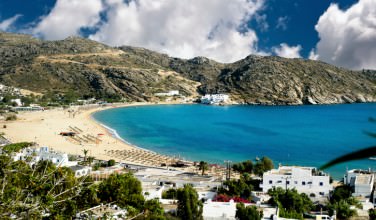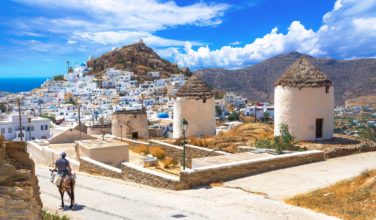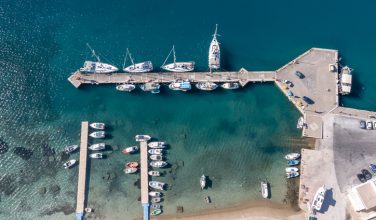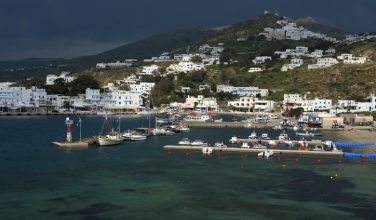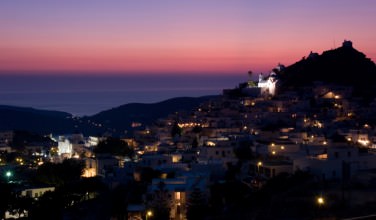Ios is a Greek island in Cyclades group located in the Aegean Sea. Ios is a hilly island. There are many cliffs that go straight down to the sea. Kastro 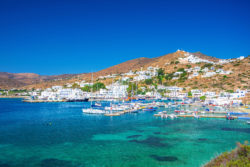 Peak (also known as Pyrgos) is the highest point on the island at 723 meters. Kastro is located at the center of the island and the next three highest peaks are around it. The island of Ios consists mainly of metamorphic rock. The island of Ios has what is names the “Plan Homer,” which is a plan in the event of earthquakes, wildfires, and other extreme events.
Peak (also known as Pyrgos) is the highest point on the island at 723 meters. Kastro is located at the center of the island and the next three highest peaks are around it. The island of Ios consists mainly of metamorphic rock. The island of Ios has what is names the “Plan Homer,” which is a plan in the event of earthquakes, wildfires, and other extreme events.
The island of Ios has strong ties to Homer because according to legend, the island is where he died. Homer is said to have visited the Delphia oracle to ask about his parents and origins. The oracle told him that his mother’s home was the island of Ios, which would accept him when he died. She also told him to be careful of the enigma of young children. When he traveled to the island of Ios, he came upon some children fishing. They told him a story that would leave him bewildered and he ran away, remembering the warning from the oracle. Homer would slip and fall on the muddy road, dying almost instantly. Another version of the legend, Homer died from sadness of not being able to solve the children’s riddle. A third version says he was already sick and knowing he would die, went to Ios. Because myths and traditions were passed from mouth to mouth, it’s not known which version is correct.
When the Greek war of Independence began in 1821, the island of Ios was one of the first islands to raise the flag of revolution. The island didn’t have a strong naval force, but took part in the battle at Kusadasi in 1921, the Second National Assembly at Astros in 1823, and the Third National Assembly at Troezen in 1827.
Administrative Region for Ios Island, Greece
Thira
Area of Ios Island, Greece
109.024 km2 (42.094 sq mi)
Population of Ios Island, Greece
2,024
Top Attractions in Ios Island, Greece
Archaeological Site of Skarkos – An early Bronze Age settlement in Skarkos. Very well-preserved. At 1.1 hectares it is the largest are best preserved site of the Keros-Syros culture. Thought that up to 300 people lived there.
Paleokastro Castle – A Byzantine castle on the eastern side of the island. A beautiful winding path leads you up to the castle. Built in 1397 AD, the castle is shaded by an olive tree on the right side.
Homer’s Tomb – Located in the northern part of the island. Tomb sits 300 meter walk up a hill. The small square structure of marble and stone sits a meter tall.
Odysseas Elytis – An open-air amphitheatre located behind the windmills on top of the village of Chora. Wonderful views of the Aegean Sea, Santorini, and Mylopotas Beach. Built of stones and marble and was named for Greek poet Odysseas.
Mylopotas Beach – A Blue Flag beach often listed in the “Top 10 Beaches in Europe.” Beautiful golden sand and crystal clear water. Sun beds and umbrellas are available for rent, there are two spots to play volleyball, and many places to eat nearby.
Agia Theodoti Beach – 14 km from Ios Village. A horseshoe-shaped beach with mountains at both ends. Enjoy a view of the 16th century Byzantine Church of Saint Theodoti on the hill.
Agia Irini Church – Located to the right of the port of Ios. A Byzantine church built in the 17th century. This church features two bell towers and two domes.
Archaeological Museum – Located on the ground floor of the town hall. Museum consists of four rooms. Learn about the history of Ios and view items from the prehistorical settlement of Skarkos.
Manganari Beach – 23 km from the village of Ios. This beach is more like a series of sandy coves that shape into small beaches. A Blue Flag beach with sun beds and umbrellas situated near the water sports.
Koumbara Beach – A quieter beach with sun beds and umbrellas to rent during peak season. Features soft golden sand and beautiful sunsets. Beach can be reached by bus, car, scooter, or foot.


